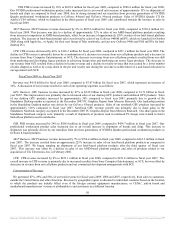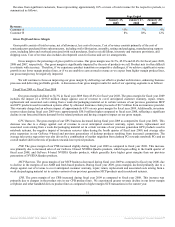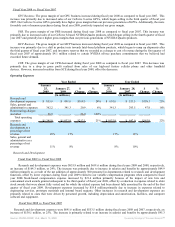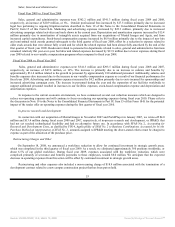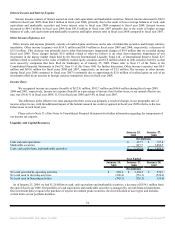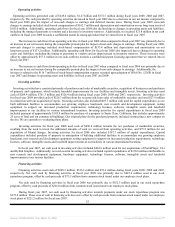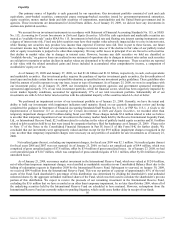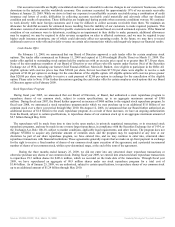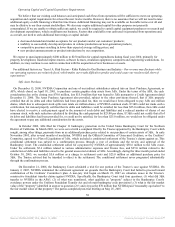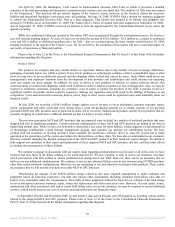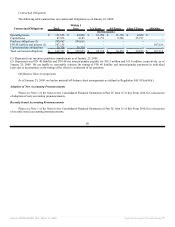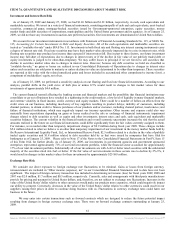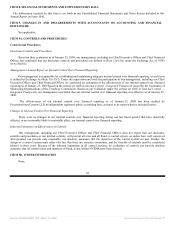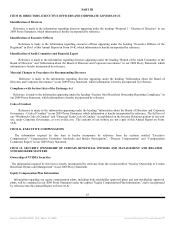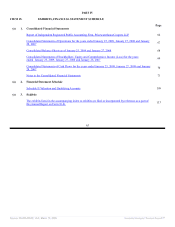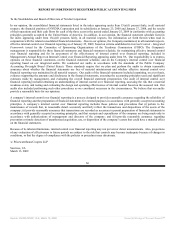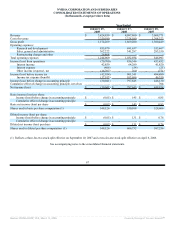NVIDIA 2009 Annual Report Download - page 71
Download and view the complete annual report
Please find page 71 of the 2009 NVIDIA annual report below. You can navigate through the pages in the report by either clicking on the pages listed below, or by using the keyword search tool below to find specific information within the annual report.
Operating Capital and Capital Expenditure Requirements.
We believe that our existing cash balances and anticipated cash flows from operations will be sufficient to meet our operating,
acquisition and capital requirements for at least the next twelve months. However, there is no assurance that we will not need to raise
additional equity or debt financing within this time frame. Additional financing may not be available on favorable terms or at all and
may be dilutive to our then-current stockholders. We also may require additional capital for other purposes not presently
contemplated. If we are unable to obtain sufficient capital, we could be required to curtail capital equipment purchases or research and
development expenditures, which could harm our business. Factors that could affect our cash used or generated from operations and,
as a result, our need to seek additional borrowings or capital include:
• decreased demand and market acceptance for our products and/or our customers’ products;
• inability to successfully develop and produce in volume production our next-generation products;
• competitive pressures resulting in lower than expected average selling prices; and
• new product announcements or product introductions by our competitors.
We expect to spend approximately $200 million to $250 million for capital expenditures during fiscal year 2010, primarily for
property development, leasehold improvements, software licenses, emulation equipment, computers and engineering workstations. In
addition, we may continue to use cash in connection with the acquisition of new businesses or assets.
For additional factors see “Item 1A. Risk Factors - Risks Related to Our Business and Industry - Our revenue may fluctuate while
our operating expenses are relatively fixed, which makes our results difficult to predict and could cause our results to fall short of
expectations.”
3dfx Asset Purchase
On December 15, 2000, NVIDIA Corporation and one of our indirect subsidiaries entered into an Asset Purchase Agreement, or
APA, which closed on April 18, 2001, to purchase certain graphics chip assets from 3dfx. Under the terms of the APA, the cash
consideration due at the closing was $70.0 million, less $15.0 million that was loaned to 3dfx pursuant to a Credit Agreement dated
December 15, 2000. The Asset Purchase Agreement also provided, subject to the other provisions thereof, that if 3dfx properly
certified that all its debts and other liabilities had been provided for, then we would have been obligated to pay 3dfx one million
shares, which due to subsequent stock splits now totals six million shares, of NVIDIA common stock. If 3dfx could not make such a
certification, but instead properly certified that its debts and liabilities could be satisfied for less than $25.0 million, then 3dfx could
have elected to receive a cash payment equal to the amount of such debts and liabilities and a reduced number of shares of our
common stock, with such reduction calculated by dividing the cash payment by $25.00 per share. If 3dfx could not certify that all of
its debts and liabilities had been provided for, or could not be satisfied, for less than $25.0 million, we would not be obligated under
the agreement to pay any additional consideration for the assets.
In October 2002, 3dfx filed for Chapter 11 bankruptcy protection in the United States Bankruptcy Court for the Northern
District of California. In March 2003, we were served with a complaint filed by the Trustee appointed by the Bankruptcy Court which
sought, among other things, payments from us as additional purchase price related to our purchase of certain assets of 3dfx. In early
November 2005, after several months of mediation, NVIDIA and the Official Committee of Unsecured Creditors, or the Creditors’
Committee, agreed to a Plan of Liquidation of 3dfx, which included a conditional settlement of the Trustee’s claims against us. This
conditional settlement was subject to a confirmation process through a vote of creditors and the review and approval of the
Bankruptcy Court. The conditional settlement called for a payment by NVIDIA of approximately $30.6 million to the 3dfx estate.
Under the settlement, $5.6 million related to various administrative expenses and Trustee fees, and $25.0 million related to the
satisfaction of debts and liabilities owed to the general unsecured creditors of 3dfx. Accordingly, during the three month period ended
October 30, 2005, we recorded $5.6 million as a charge to settlement costs and $25.0 million as additional purchase price for
3dfx. The Trustee advised that he intended to object to the settlement. The conditional settlement never progressed substantially
through the confirmation process.
On December 21, 2006, the Bankruptcy Court scheduled a trial for one portion of the Trustee’s case against NVIDIA. On
January 2, 2007, NVIDIA terminated the settlement agreement on grounds that the Bankruptcy Court had failed to proceed toward
confirmation of the Creditors’ Committee’s plan. A non-jury trial began on March 21, 2007 on valuation issues in the Trustee's
constructive fraudulent transfer claims against NVIDIA. Specifically, the Bankruptcy Court tried four questions: (1) what did 3dfx
transfer to NVIDIA in the APA?; (2) of what was transferred, what qualifies as "property" subject to the Bankruptcy Court's
avoidance powers under the Uniform Fraudulent Transfer Act and relevant bankruptcy code provisions?; (3) what is the fair market
value of the "property" identified in answer to question (2)?; and (4) was the $70 million that NVIDIA paid "reasonably equivalent" to
the fair market value of that property? The parties completed post-trial briefing on May 25, 2007.
58
Source: NVIDIA CORP, 10-K, March 13, 2009 Powered by Morningstar® Document Research℠



